|
Is VFR too negative? And a photo tour of Hell Gate Bridge
Jim C. writes:
I suggest you start doing regular postings on things you like—cultural, political, whatever.
When you think about it, your blog could rightfully be called Things That Really P*** Larry Off.
LA replies:
I know what you mean. Right now I don’t have the energy or inclination for that. What I normally do, day by day, is respond to things that are happening—the passing scene, as it says in the VFR masthead—which happen to be overwhelmingly, apocalyptically negative. Writing about good things takes significantly more work.
For example, I’ve recently started reading The Iliad for the first time in many years. It’s one of the greatest things in the world and I have things to say about it. But bringing those things out involves a kind of writing that takes much more work and time.
Last week a friend and I drove onto Randall’s/Ward’s Island and took a close look at the Hell Gate Bridge, comparing its remarkable and unusual structure to the Triborough Bridge which is right next to it and which is a classic suspension bridge. These are wonderful things, worth writing about. But I’m not oriented to that kind of writing right now.
Still, you are right and I will make more of an effort to write, at least occasionally, about good things.
Also, Laura Wood at The Thinking Housewife regularly posts on cultural things she likes, particularly 19th century paintings. Also Kidist Paulos Asrat at Camera Lucida writes very interesting cultural criticism but also writes about cultural things she likes.
- end of initial entry -
Mark A. writes from Tennessee:
I hope you are reading Richmond Lattimore’s translation of the Iliad, which is as close to the Greek as one can come in English. And I hope you are not reading the popular Robert Fagles translation, which is very, very far from the Greek.
LA replies:
Not to worry. I’ve been a Lattimore man since I was 13 years old, when I discovered his translation of The Iliad. At about age 30 I learned by heart the first book of The Iliad, and recently re-learned much of it, because I had let it go over the years. The way Lattimore keeps true to Homer’s hexameter (six beat) line with his own unique English syntax never stops affecting me. I think his translation is a work of genius in its own right.
Also, I find the Fagles unreadable. In fact, I had an exchange about this with a friend two days ago:
Friend:
Are you familiar with Fagles’ translation at all? Is it very different from Lattimore’s?
Me:
I looked at it a bit in the ’90s. I see it as an attempt to appeal to a contemporary sensibility—jagged, hyperkinetic, broken up. I was repelled by it and put it aside.
Me (cont.):
I may be unfair to Fagles. I didn’t read that much of it. But the reason I didn’t read that much of it was that I couldn’t stand it.
I feel he was very deliberately trying to appeal to the contemporary decadent post-modern culture of the 1990s.
Mark A. replies: Great—and I agree whole-heartedly with your analysis of Fagles’s intentions.
A reader writes: I don’t think VFR is too negative, or is filled with pointless rants, and anyway, how much the hell is one person supposed to do?
Sam writes:
Is VFR too negative? This is like asking whether VFR is too accurate. When you live in a culture that is thoroughly permeated by decadence, indecency, and lies, how could the predominant thoughts of any sane human being fail to turn negative? Especially when we have, fresh in our minds, a real vision of what our culture has been and could be once again. A vision of a culture that was not in decay, or indecent, or constructed upon lies. VFR tells the truth about the world as it is, and the world as it is a very depressing place. But being negative is not the same thing as being despairing. One cannot hope to escape a dysfunctional reality unless one is also willing to confront that reality as it truly is. And the West is truly in a bad state. But we are not finished, and the only way to begin the task of reversing the decay is to stare it right in the face and call it what it is. If this seems negative, then such are the times in which we live.
Bill Carpenter writes:
Are you re-reading Lattimore’s translation? It remains my favorite after reading Fitzgerald’s and Fagles’, and sampling a couple of others (e.g. Chapman’s). It shares an urgent, driving quality with the Gospel of St. Mark.
LA replies:
Funny you should mention that. Recently I’ve memorized the first chapter of the Gospel of Mark (King James version).
Bill Carpenter replies:
Good man! James Joyce set himself to memorizing as he got older to keep his mind sharp.
LA replies:
Well, I’m not doing it to keep my mind sharp or for any practical reason like that. I just enjoy it—enjoy having long sections of great poetry or the Bible as a part of myself, and not just in a book. But it’s very hard work. Memorizing the Bible, especially the King James Version (and even more especially the narrative parts as distinct from the Psalms or the discourses of Jesus), is vastly more difficult than memorizing verse, because the language of the KJV is “lumpy.” I don’t mean ugly, of course. I mean that the language is extremely irregular and does not fall into any patterns to aid memorization, the way verse does.
At the same time the work of memorization is enjoyable and relaxing, because it doesn’t involve intellectual work, dealing with ideas. It’s mechanical work, remembering words. It uses a different part of the brain. For example, after eating, one does not want to do intellectual work. But memorization can be relaxing.
Bill Carpenter replies:
Did you ever read Njal’s Saga? To my mind it is the true Northern Iliad, though it is in prose.
LA replies:
I haven’t read it.
Bill Carpenter replies: It’s the greatest of the Icelandic sagas, written in the 12th c. and set around 1000. Good men strive to keep the peace while those around them thirst for revenge. I’m re-reading the good Penguin translation by Robert Cook.
D. Edwards writes:
You write:
“Last week a friend and I drove onto Randall’s/Ward’s Island and took a close look at the Hell Gate Bridge, comparing its remarkable and unusual structure to the Triborough Bridge which is right next to it and which is a classic suspension bridge. These are wonderful things, worth writing about. “
If time does not permit you to write about such things could you at least take pictures of what you are exploring and post them?
LA replies:
That’s possible. For starters I’ve linked, above, the Wikipedia article on Hell Gate Bridge. Here’s one of the photos at Wikipedia:
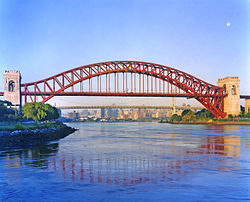 Also photos from last week’s visit may be available.
Also photos from last week’s visit may be available.
LA writes: Dean Ericson has just sent the photos he took last Thursday during our walk around the west pier of the main span of the Hell Gate Bridge on Randall’s/Ward’s Island, a large combined island between the East River and the Harlem River. All the photos are by Dean except the one I took of him in his sartorial splendor. (If I had known that photos would be taken of me that day and that I would be posting them online, I would have dressed better myself.) Hell Gate is a railroad bridge, completed in 1916, that connects New York City and New England and is still being used today by Amtrak.
It’s fascinating to see Hell Gate Bridge and the main span of the Triborough Bridge next to each other. They both cross the rather isolated and almost countrified part of the East River that descends from Long Island Sound east of Randall’s/Ward’s Island before it turns west and becomes the main part of the East River that runs along the East Side of Manhattan.
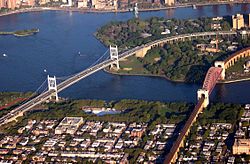
Triborough Bridge, left, and Hell Gate Bridge,
crossing from Queens, in foreground, to Ward’s
Island, with Manhattan beyond.
The Hell Gate bridge is held up by a complex steel arch (consisting of two parallel “chords,” with upside-down V-shaped trusses connecting the chords) that runs into the base of two huge granite towers or piers at both ends of the span. Vertical supports hang down from this steel arch, holding up the main span of the bridge. So the Hell Gate and the Triborough are complements of each other, the Triborough held up by downward curving cables hanging from its two towers in the classic manner of suspension bridges such as the George Washington Bridge and the Brooklyn Bridge; and the Hell Gate held up by an upward curving steel arch rooted in the subterranean base of two stone piers.
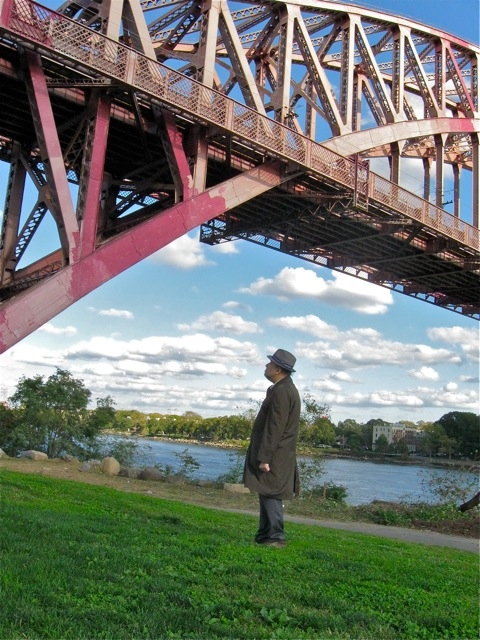
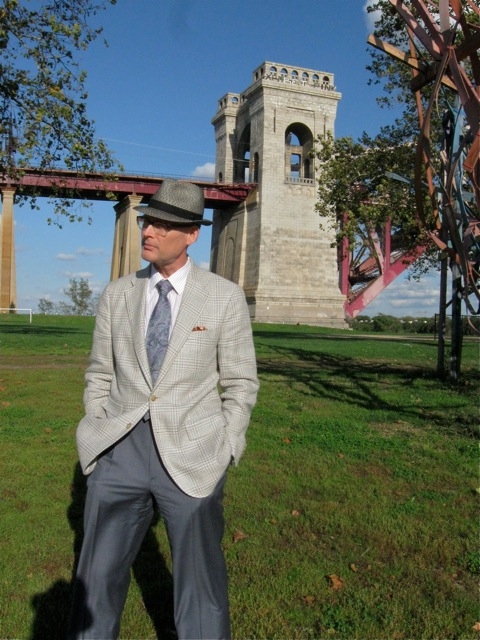
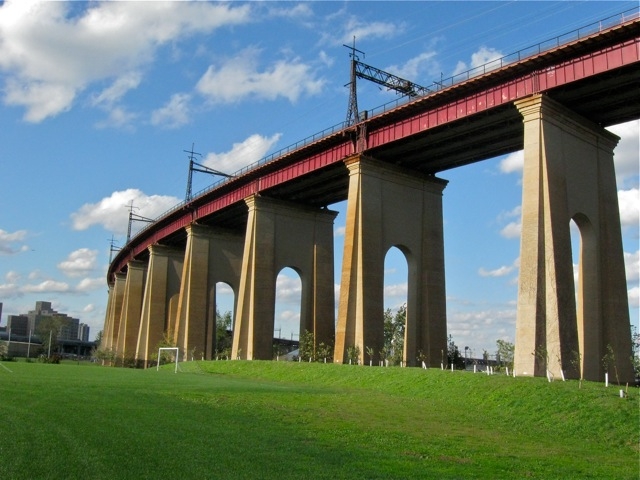
Apart from the main span of Hell Gate Bridge that crosses the East River
between Randall’s/Ward’s Island and Queens, most of the bridge is like
what you see here—a series of concrete piers holding up the bridge from
underneath as the bridge goes over Randall’s/Ward’s Island. Those piers
are an understated masterpiece of design in themselves.
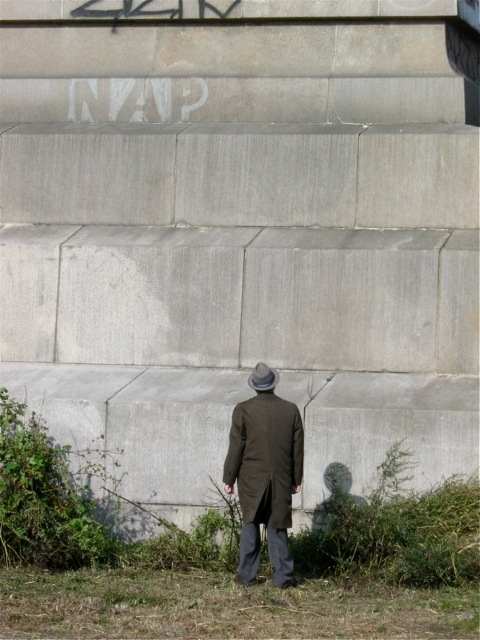
Standing at the base of the west tower or pier.
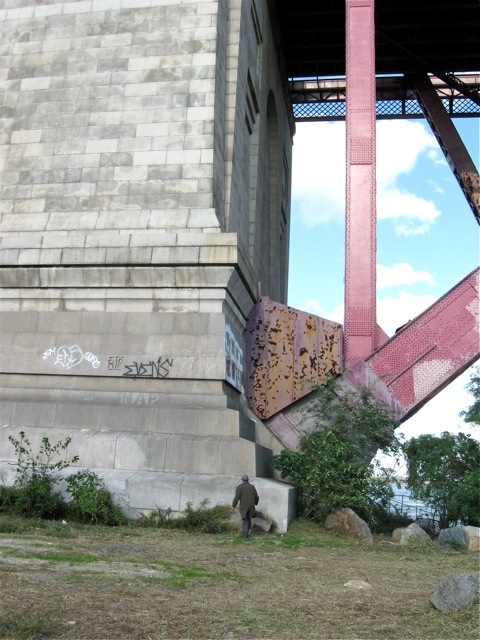
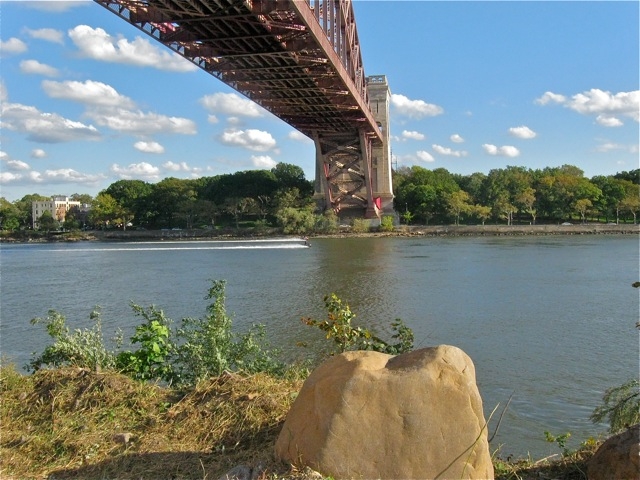
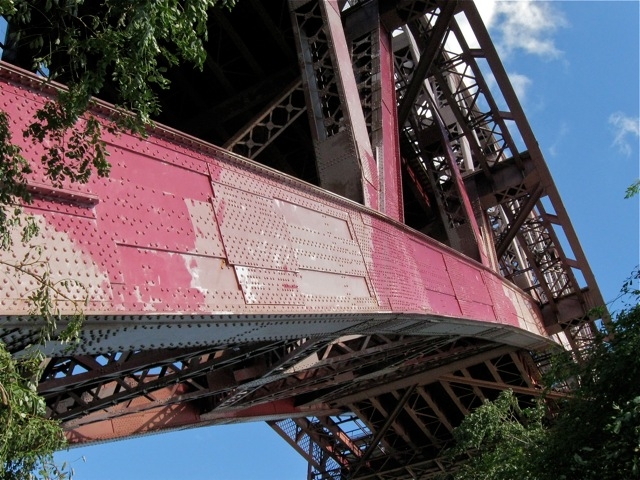
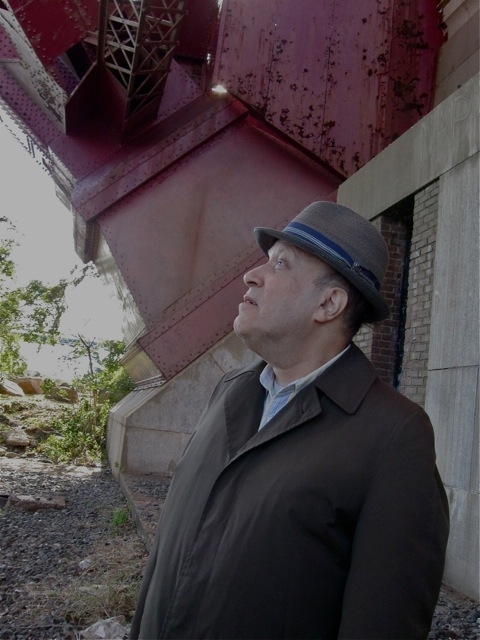
Where the steel arch runs into the base of the granite pier.
Basically the entire bridge is held up by the meeting
place of steel and granite behind me.
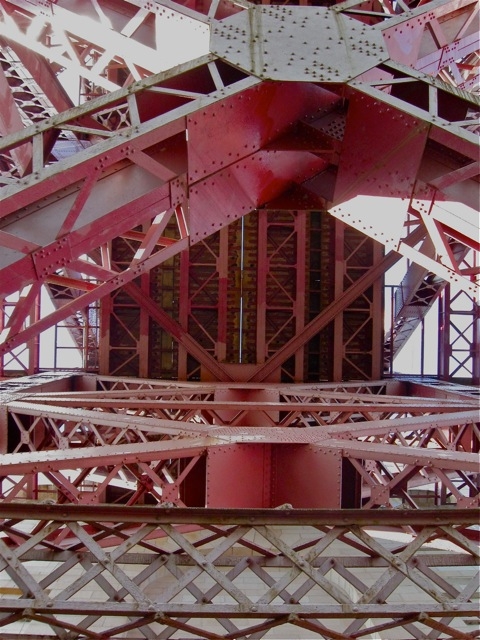
October 27
Robert B. writes:
I love it. The bridge is beautiful and we have, in fact, a miniature version of it here, spanning the Mississippi. But, what really adds to the photo essay are the two gentleman in the photo essay. To a Minnesotan, they appear to be quintessential New Yorkers.
LA replies:
But Mr. Ericson is a native Minnesotan.
Robert B. replies: Well, he looks the part—what can I say?
Stogie writes:
Loved those pictures of the Hell Gate bridge. The one shot with you looking up, with the sky filled with clouds, is excellent. What a beautiful fall day that was.
I looked at the Wikipedia article on the bridge, and the 1917 photo of it, when it was brand new, shows that it looks very much the same after almost a century. Except for some graffiti, of course. This bridge was built to last.
LA writes:
This post is yet another example of serendipity, synchronicity, small “p” providence, or whatever you wish to call it.
I hadn’t seen the great photos that Dean had taken of Hell Gate last Thursday and so of course I had no thought of posting them.
Then a reader, Jim C., stated that VFR is just an occasion for me to be negative and that I should talk about cultural things I like. That led me to mention our visit to Hell Gate as an example of something positive. I still had no thought of the photos because I hadn’t even seen them. Then another reader, D. Edwards, asked if I could post photos of the things I like including the bridge, and that led to them being posted. And of course Mr. Edwards had no notion that we already had a bunch of photos of the Hell Gate excursion.
Step by step, the statement of a third party led ultimately to the photos being posted. It was as though it happened despite my own or anyone else’s thoughts and will, as though some external force were directing events toward that end.
A reader writes:
Why is it called Hell Gate?
LA replies:
The Wikipedia article on Hell Gate has information on the name. It’s an anglicization of a Dutch name:
The name “Hell Gate” is a corruption of the Dutch phrase Hellegat, which could mean either “hell’s hole” or “bright gate/passage”, which was originally applied to the entirety of the East River. The strait was described in the journals of Dutch explorer Adriaen Block, who is the first European known to have navigated the strait, during his 1614 voyage aboard the Onrust. Hellegat is a fairly common toponym for waterways in the Low Countries, with at least 20 independent examples. Because explorers found navigation hazardous in this New World place of rocks and converging tide-driven currents (from the Long Island Sound, Harlem River strait, Upper Bay of New York Harbor and lesser channels, some of which have been filled), the Anglicization stuck.
Jim C. writes: nice Hell Gate!
Karl D. writes:
Ah, the two of you standing under and admiring man’s achievement. It’s downright Randian! ; )
If I didn’t know better judging from the photos of you and Mr. Ericson, I would say the year was about 1962. He looks like the architect and you look like a hard boiled detective on the case of a body that just washed up on the river bank. Did she jump from the bridge? Or was she pushed?
LA replies:
I do sort of look like a grungy NYC homicide detective in those photos, don’t I?
In fact, I had that same thought before your comment came.
Also, I have previously said to Mr. Ericson that he looks like someone from the early 1960s.
Karl D. replies:
You wrote:
“I do sort of look like a grungy NYC homicide detective in those photos, don’t I?”
Here is a picture of Gene Hackman from “The French Connection.” You could be Larry “Popeye” Auster!
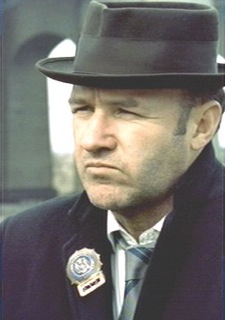
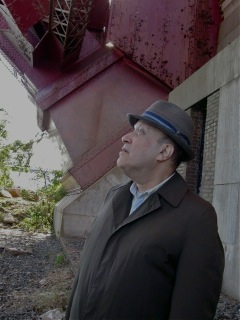
Laura Wood writes:
Except your raincoat is more Columbo than French Connection.
November 18, 2012
LA to Dean Ericson:
I was just looking at this entry because I sent it to someone.
Then it occurred to me: If I with my ratty raincoat and stooped posture was Lieutenant Columbo in these scenes, as readers suggested, then you, the tall, well-dressed Nordic, would be the murderer whom I am closing in on. On that program, without exception, the murderer was always an “elite,” cold, aloof, well-dressed Anglo/Nordic type whom Columbo, the ratty, messy ethnic, slowly closes in his trap, taunting his prey like a cat playing with a mouse. The show (which, of course, was largely created and written by Jews) was basically a parable of the white ethnics gaining control over and displacing the hated Anglo-Saxon Protestant, and so leading the way to the wonderful multicultural paradise we now inhabit.
Wikipedia says this about the show:
Class tension is often apparent between Columbo—with his seemingly humble, working class origins—and the killer, who is usually affluent, well-positioned and condescending. The killer’s arrogance and dismissive attitude help Columbo with his investigation, as he manipulates his suspects into self-incrimination. With the final arrest, the killer always goes quietly.
Right. Just as Anglo America, found “guilty,” has gone quietly.
Dean Ericson replies:
Anglo America played a central role in their own delegitimization and dispossession by not identifying, opposing, and stopping the left/liberal assault on their civilization. It’s easy to blame the Jews, but what about my people, the Scandinavians? They’re mostly as fanatically liberal as many Jews. True, Jews had more insidious power in the media but it’s not as if we’re mindless puppets knee-jerking to Jewish strings; we truly loved our liberalism and it was in our bones long before Jews became a big presence in America. I can’t help thinking how things might have gone had we taken John Adams’s words more to heart at the Founding. I mean that business about how our Constitution was made only for a moral and religious people, meaning, Christian. What if we had excluded, from the beginning, all not of European Christian heritage? Would that have prevented our decay into liberalism? I doubt it. The French Revolution was undertaken entirely by European Christians. That’s not to say there wouldn’t have been some benefit to America in excluding Africans, Jews, Muslims, Asians (and the Irish, save those named “Wood” and “McLaughlin”), but blaming it all on the Jews is a cheap way of letting us off the hook.
Posted by Lawrence Auster at October 26, 2011 11:57 AM | Send
|



